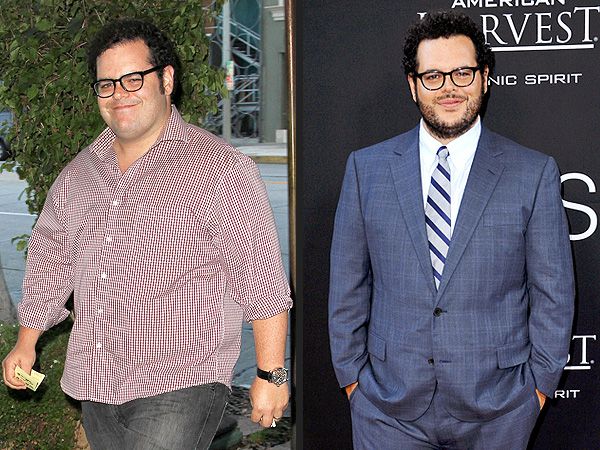Josh Gad, best known for his iconic voice role as Olaf in Frozen, has been open about his weight loss journey, inspiring many with his candidness and transformation. Over the past few months, Gad has successfully lost 40 pounds and has spoken out about his challenges, the methods he used, and the mental shifts required to achieve this goal. His journey highlights not just physical change, but also emotional growth, self-reflection, and an honest approach to body image.

The Start of the Journey: Facing Personal Challenges
For much of his career, Gad was known for his “funny fat guy” persona. He embraced his larger-than-life image and used it to his advantage in his acting and comedy roles. However, as he entered his 40s, Gad started to reflect more seriously on his health. It wasn’t about the pressures of Hollywood or trying to meet anyone else’s standards—it was about feeling better, being more energized, and living a longer, healthier life for himself and his family.
“After turning 40, I really started to realize that I needed to do something for myself,” Gad shared in a recent interview. “It wasn’t just about appearance—it was about feeling good and being around for the people I love.”
As he approached this milestone, Gad found himself weighing more than he felt comfortable with. His health concerns, combined with the typical pressures of maintaining a certain image in the public eye, prompted him to make changes.
“I was tired of feeling sluggish, I was tired of being winded after simple activities, and I wanted to be the best version of myself,” he added.
The Decision to Take Action: Exploring the Options
For Gad, losing weight wasn’t about following trends or getting the quickest result. He wanted a balanced, sustainable approach. He started by evaluating various options for achieving weight loss, including diet, exercise, and other health interventions.
It was then that Gad turned to weight loss medication, which played a significant role in his transformation. He started using a GLP-1 medication, a class of drugs often prescribed for people with type 2 diabetes that has also shown effectiveness in weight loss. In interviews, Gad admitted that this medication, combined with changes to his diet and lifestyle, helped him lose 40 pounds.
“I was initially skeptical about using a medication for weight loss,” he said. “But after discussing it with my doctor and doing some research, I decided to give it a try. And it really worked for me.”
While the medication was a helpful tool, Gad emphasized that it wasn’t a “magic pill.” It was just one part of a broader strategy to improve his overall health. He was clear that the medication couldn’t replace the need for a healthy relationship with food, exercise, and his own self-care.
Dietary Adjustments: Small Changes, Big Impact
Diet was a crucial aspect of Gad’s transformation. He didn’t follow any extreme crash diets or make drastic changes overnight. Instead, he adopted a more mindful approach to eating. Gad started by working with a nutritionist who helped him develop a plan that suited his needs, focusing on making healthier food choices that he could sustain.
“Before, I wasn’t making the best food choices. I didn’t prioritize what I was eating, and it showed in my energy levels,” he shared. “Now, I focus on whole foods, lean proteins, and vegetables. I’m still eating the foods I enjoy, but in moderation.”
One of the key adjustments Gad made was cutting back on processed foods and reducing his intake of sugars and unhealthy fats. He incorporated more balanced meals, focusing on foods that provided nutrients and energy without leaving him feeling deprived.
“I started paying attention to my food not just as something to fill me up, but as fuel for my body,” he explained. “It’s about balance, not restriction.”
Exercise: Finding Enjoyable Movement
While diet played a significant role, Gad also realized that physical activity was essential for his overall well-being. However, the thought of jumping into intense workouts immediately felt daunting. Instead, Gad began with manageable and enjoyable activities that fit into his routine, making exercise something he could sustain over time.
“I didn’t want to push myself too hard at first. I started with walking and light cardio, and then gradually incorporated more strength training,” he explained. “Now, I’m lifting weights and doing things I never thought I’d enjoy.”
For Gad, the key was finding exercises that felt fun, rather than forcing himself into an intense regimen that would quickly burn him out. By focusing on activities he enjoyed, such as hiking and playing sports with his kids, Gad made fitness a regular part of his life without feeling overwhelmed.
“I think the biggest thing for me was realizing that I don’t have to do something I hate to get results,” he shared. “Exercise doesn’t have to be a punishment. It should be something that makes you feel good.”
Mental and Emotional Shifts: Overcoming Anxiety and Pressures
In addition to physical changes, Gad’s weight loss journey required significant mental and emotional work. He had to confront old habits, anxieties, and perceptions about himself, and work through the pressures that often come with being in the public eye.
“I’ve always been a bit anxious, especially around my body and how people perceive me,” he admitted. “But this journey wasn’t just about losing weight. It was about finding peace with myself and my body.”
Throughout his transformation, Gad practiced mindfulness and self-compassion, taking time to focus on his mental health. He acknowledged the importance of self-reflection and making peace with his body at every stage of the process. This emotional growth was just as significant as the physical changes he was making.
“There were times when I felt guilty or frustrated with myself. But I had to remind myself that it’s a process,” he shared. “I had to learn to give myself grace, and not be so hard on myself.”

Challenges Along the Way: Side Effects and Setbacks
While Gad’s journey has been largely positive, it hasn’t been without its challenges. After losing 40 pounds with the help of the GLP-1 medication, Gad began to experience some side effects, including an intestinal condition known as diverticulitis. This condition required him to stop using the medication and switch to a different weight loss drug.
“It was really disappointing,” he said. “I had seen such great results, and it was working for me. But I had to stop because of the side effects. It just reminded me that weight loss isn’t a one-size-fits-all solution.”
Despite this setback, Gad remained optimistic and focused on continuing his journey with other strategies, including further adjustments to his diet and fitness routine.
The Outcome: A New Perspective on Health and Self-Care
Josh Gad’s weight loss journey ultimately helped him lose 40 pounds and improved his overall health, but it also gave him a renewed sense of confidence and self-awareness. “I’m in a much better place now. I feel healthier, more energized, and more confident in myself,” he said.
More importantly, the journey helped Gad cultivate a healthier relationship with his body and food. He recognized that the process wasn’t about reaching a specific number on the scale, but about improving his well-being and mindset.
“I’m proud of what I’ve achieved, but I’ve also learned to appreciate the process,” Gad reflected. “It’s not just about the destination. It’s about the small changes you make along the way and how those changes can shape your life.”
Inspiration for Anyone on a Similar Journey
Josh Gad’s story is a powerful reminder that weight loss is not just about physical transformation—it’s about emotional growth, self-care, and the mindset shifts that happen along the way. His journey has been about learning to take care of himself, both mentally and physically, and finding a sustainable way to live a healthier life.
For those who are struggling with their own weight loss journey, Gad’s story offers hope, honesty, and practical advice. Whether it’s making small dietary changes, finding enjoyable ways to exercise, or focusing on mental health, Gad’s approach shows that with patience, consistency, and self-compassion, anyone can achieve their own version of success.